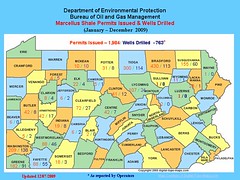By Peter Mantius
The Odessa File
BURDETT, Nov. 13 -- When the state recently tested brine extracted from all 12 of New York’s active Marcellus Shale natural gas wells, several of the samples were highly radioactive.
Six of those tested wells, including the four found to be the most contaminated, are located in Schuyler County.
The tests conducted between October 2008 and April 2009 found that wastewater from the six deep vertical wells in Orange, Dix and Reading showed concentrations of Radium 226 ranging from 60 to 260 times the legal limit for discharge into the environment.
The results could complicate plans for aggressive natural gas drilling locally and lead to calls for more active radiological monitoring throughout the Marcellus Shale drilling region, including Pennsylvania.
“Whatever entity produces those kinds of numbers will have to be licensed by the state,” said Theodore G. Adams, a radiological and environmental consultant in suburban Buffalo. “The waste will have to be managed, treated and disposed of (to avoid human contact).”
Radium 226, which is intensely radioactive, has a half-life of 1602 years and decays into radon gas.
In July, the state Department of Health expressed concerns about the test results in a confidential letter to the Department of Environmental Conservation, which conducted the tests.
Existence of the letter was recently reported by the website ProPublica. DEC confirmed that it received the letter but denied my repeated requests for a copy.
So far, the agency isn’t raising alarms about the test results, saying radioactivity readings can vary widely at any given site.
But if further testing confirms that the readings are roughly accurate indicators of current radioactivity levels, it could significantly drive up the cost of extracting natural gas.
Sites that consistently turn in high radiological readings for their brine would need to obtain special licenses, said Adams, a former federal Department of Energy radiation inspector who runs his own firm that serves clients such as Westinghouse and Alcoa.
Adams noted that wastewater or sludge from such wells would likely require expensive special handling.
Fortuna Energy Inc. of Horseheads operates several of the wells that showed high radioactivity readings, ProPublica has reported. But Mark Scheuerman, Fortuna’s general counsel, declined Friday to confirm or deny the company’s involvement. He said the company planned to address a myriad of drilling issues in written comments to the DEC by yearend.
The DEC conducted extensive radiological tests of New York State natural gas wells in 1999 and found little cause for concern. But none of those were Marcellus wells. In contrast, all of the recent tests were Marcellus wells (six in Schuyler, five in Steuben County and one in Chenango County), and several of them showed much higher readings than any of the 1999 tests.
The results are buried deep in an appendix to the state’s draft Generic Environmental Impact Statement for gas drilling. The charts are presented without any explanation or footnotes.
But the simple numbers speak powerfully, according to Adams.
For example, one well in Orange showed Radium 226 concentrations of 16,030 picocuries per liter. Adams said the state and federal limit for legal discharges into the environment is 60 picocuries per liter.
The legal limit for drinking water is 5 picocuries per liter. The limit for water treated at a sewage treatment plant is 600 picocuries per liter.
Three other Schuyler County wells also showed readings of more than 10,000 picocuries per liter. The highest reading detected outside Schuyler County was 7,885 picocuries per liter at a well in Steuben County. (The findings were reported with uncertainty levels of roughly 25 percent).
All 12 of the tested wells were drilled vertically in the Marcellus Shale, a rock formation several thousand feet below the surface that extends through most of the Southern Tier, Pennsylvania and parts of West Virginia and Ohio.
...Although previous public hearings on drilling have touched on a host of environmental issues, radioactivity hasn’t been a prime concern.
Yancey Roy, a spokesman for the DEC, ...said the 12 tested wells were the only active Marcellus Shale wells in the state. And while more radiological testing is needed, he said, that can’t occur until new drilling operations get underway.
Once fracking begins in New York, “decisions will be made, based on the results, as to the proper handling and disposal of waste materials,” he added.
In the past, brine has been used on state roads to help melt snow. (!!!)
An appendix to the proposed DEC drilling rules says: “The modeling showed that the most common method of brine disposal in New York State, spreading it on the roads to control ice and snow, does not present significant (radiation) doses to the public.”
Roy noted that the DEC is concerned about potential buildup of radioactivity in pipes and other drilling equipment and said that equipment may have to be monitored. NORM is also apt to accumulate in sludge that is a byproduct of well wastewater.
For the complete report, CLICK HERE.
DEMAND ACCOUNTABILITY!



















No comments:
Post a Comment